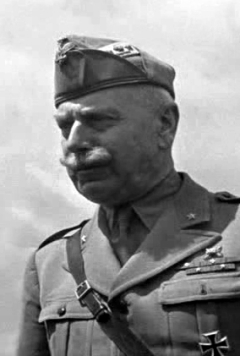Related Research Articles

The Battle of Stalingrad was a major battle on the Eastern Front of World War II, beginning when Nazi Germany and its Axis allies attacked and became locked in a protracted struggle with the Soviet Union for control over the Soviet city of Stalingrad in southern Russia. The battle was characterized by fierce close-quarters combat and direct assaults on civilians in aerial raids; the battle epitomized urban warfare, being the single largest and costliest urban battle in military history. It was the bloodiest and fiercest battle of the entirety of World War II—and arguably in all of human history—as both sides suffered tremendous casualties amidst ferocious fighting in and around the city. Today, the Battle of Stalingrad is commonly regarded as the turning point in the European theatre of World War II, as Germany's Oberkommando der Wehrmacht was forced to withdraw a considerable amount of military forces from other regions to replace losses on the Eastern Front. By the time the hostilities ended, the German 6th Army and 4th Panzer Army had been destroyed and Army Group B was routed. The Soviets' victory at Stalingrad shifted the Eastern Front's balance of power in their favour, while also boosting the morale of the Red Army.

Army Group South was the name of one of three German Army Groups during World War II.

Case Blue was the Wehrmacht's plan for the 1942 strategic summer offensive in southern Russia between 28 June and 24 November 1942, during World War II. The objective was to capture the oil fields of Baku, Grozny and Maikop for two purposes: to enable the Germans to re-supply their low fuel stock and also to deny their use to the Soviet Union, thereby bringing about the complete collapse of the Soviet war effort.

Operation Little Saturn was a Red Army offensive on the Eastern Front of World War II that led to battles in Don and Chir rivers region in German-occupied Soviet Union territory in 16–30 December 1942.

The 4th Panzer Army, operating as Panzer Group 4 from its formation on 15 February 1941 to 1 January 1942, was a German panzer formation during World War II. As a key armoured component of the Wehrmacht, the army took part in the crucial battles of the German-Soviet war of 1941–45, including Operation Barbarossa, the Battle of Moscow, the Battle of Stalingrad, the Battle of Kursk, and the 1943 Battle of Kiev.
Hitler: Speeches and Proclamations 1932–1945: The Chronicle of a Dictatorship is a 3,400-page book series edited by Max Domarus presenting the day-to-day activities of Adolf Hitler between 1932 and 1945, along with the text of significant speeches.

The Reichskommissariat Kaukasien, also spelled Kaukasus, was the theoretical political division and planned civilian occupation regime of Germany in the occupied territories of the Caucasus region during World War II. Unlike the other four planned Reichskommissariats, within the borders of the proposed Caucasus Reichskommissariat experiments were to be conducted for various forms of autonomy for "indigenous groups".

This bibliography of Adolf Hitler is a list of some non-fiction texts in English written about and by him. Thousands of books and other texts have been written about him, so this is far from an all-inclusive list. It has been arranged into groups to make it more manageable.

The Battle of the Caucasus was a series of Axis and Soviet operations in the Caucasus as part of the Eastern Front of World War II. On 25 July 1942, German troops captured Rostov-on-Don, opening the Caucasus region of the southern Soviet Union to the Germans and threatening the oil fields beyond at Maikop, Grozny, and ultimately Baku. Two days prior, Adolf Hitler had issued a directive to launch an operation into the Caucasus named Operation Edelweiß. German units would reach their high water mark in the Caucasus in early November 1942, getting as far as the town of Alagir and city of Ordzhonikidze, some 610 km from their starting positions. Axis forces were compelled to withdraw from the area later that winter as Operation Little Saturn threatened to cut them off.

The 11th Army was a World War II field army.

Italo Gariboldi was an Italian senior officer in the Royal Army before and during World War II. He was awarded the Knight's Cross of the Iron Cross by German dictator Adolf Hitler for his leadership of Italian forces in the Battle of Stalingrad.

The Crimea Shield was a World War II German military decoration. It was awarded to military personnel under the command of Field Marshal von Manstein, including supporting naval and air force units, who fought against Soviet Red Army forces between 21 September 1941 and 4 July 1942 and who captured the Crimea region. It was instituted on 25 July 1942. It was the most widely distributed of the various German campaign shields, with approximately 250,000 awarded.

Karl Hubert Lanz was a German general during the Second World War, in which he led units in the Eastern Front and in the Balkans. After the war, he was tried for war crimes and convicted in the Southeast Case, specifically for several atrocities committed by units under his command in the Balkans. Released in 1951, he joined the liberal Free Democratic Party and served as its adviser on military and security issues.

Operation Fischreiher was an extension to Operation Blue II during the German invasion of the Soviet Union in World War II. General Friedrich Paulus' 6th Army, and part of the 4th Panzer Army under General Hermann Hoth, was to advance across the Don river towards the city of Stalingrad on the Western bend of the Volga river.

Parliamentary elections were held in Germany on 10 April 1938. They were the final elections to the Reichstag during Nazi rule and took the form of a single-question referendum asking whether voters approved of a single list of Nazi and pro-Nazi guest candidates for the 814-member Reichstag, as well as the recent annexation of Austria. Turnout in the election was officially 99.6% with 99.1% voting 'yes' in Germany and Austria.

The 389th Infantry Division was a German division of the Wehrmacht in the Second World War, which fought for example in the Battle of Stalingrad. It was formed on 27 January 1942 in Milowitz.

The Azerbaijan Soviet Socialist Republic entered World War II with the Soviet Union after the German declaration of war on June 22, 1941. Azerbaijan's oilfields were enticing to the Germans due to the USSR's heavy dependency on Caucasus oil – setting the scene for German campaigns attempting to capture and seize the oilfields in Baku during the Battle of the Caucasus. Azerbaijan’s oil was very decisive for Soviet victory. More than 600,000 people from Azerbaijan were conscripted to the Workers’ and Peasants’ Red Army during World War II from 1941 to 1945.

The Tunnel is a 1915 German silent drama film directed by William Wauer and starring Friedrich Kayssler, Fritzi Massary and Hermann Vallentin. It is the first of several film adaptations of Bernhard Kellermann's 1913 novel Der Tunnel about the construction of a vast tunnel under the Atlantic Ocean connecting Europe and America. The film was made by Paul Davidson's PAGU production company, with sets designed by art director Hermann Warm.
References
- ↑ Schramm, 1942, Teilband 2, S. 60
- ↑ Schramm, 1942, Teilband 2, S. 1330
- ↑ Schramm, 1942, Teilband 1, S. 520
- ↑ Schramm, 1942, Teilband 2, S. 1420
- ↑ Domarus, Max. Speeches and Proclamations, 1932–1945. Wauconda, Il: Bolchazy-Carducci Publishers Inc., 2004.
- ↑ Domarus, Max. Speeches and Proclamations, 1932–1945. Wauconda, Il: Bolchazy-Carducci Publishers Inc., 2004. (p. 2654)